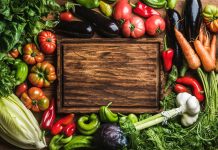High energy levels require healthy eating during the holidays. However, brain fog and lethargy due to poor diet limits us. This article navigates the tempting delicacies with helpful holiday eating tips and recipes.
Use Fresh Ingredients
It’s tricky to consume foods close to their harvest. Freshly harvested foods offer fullness with smaller portions due to the fiber content. Therefore, the feeling of fullness remains longer, and it reduces snacking.
Use fresh, raw ingredients such as sautéed green beans sprinkled with garlic and almonds; this dish creates better health than the typical green bean casserole loaded with fat and processed ingredients. The fresh green beans are nutritious and delicious. Fresh, raw foods are packed with vitamins, minerals, fiber, and all the nutrients the human body needs.
In December, pecan growers harvest in the south. Buying cracked pecans and shelling them is economical. Try the nuts in holiday recipes and eat them as a high protein snack. Freeze pecans in mason jars to use throughout the year. What type of nuts grow in your area and how can use them?
Recently I brought a broccoli pomegranate salad to a Thanksgiving dinner. The mixture contained fresh broccoli, pomegranate, and pecans. Everyone raved about it, and two people requested the recipe (see recipe below). You can find many nutritious recipes on Pinterest.
Baking
When baking, use coconut, almond, or quinoa flour instead of white or wheat flour. Also, use sugar substitutes such as stevia and monk fruit sweetener. Both of these sweeteners rank zero on the glycemic index and have no calories! Desserts made with these ingredients are as tasty as the usual sugar-laden culprits.
Over Thanksgiving I made a delicious loaf of banana pecan bread using coconut flour. One of my family members is gluten sensitive, and the other is lactose intolerant; yet we made delectable deserts out of wholesome, organic, gluten-free ingredients.
Christmas Parties
At parties, avoid eating foods made with wheat and sugar. Instead, eat nuts, fruits, and vegetables. Serve yourself healthy dips like Guacamole and hummus. These foods satisfy our taste buds.
Here’s a suggestion on how to serve yourself smaller portions. Think of your stomach as the size of your fist. Put less food on your plate than you think you will eat. Using a smaller plate may help.
As soon as you feel full, stop eating and wait a few minutes. Many times you won’t feel hungry anymore since it takes a little while for your brain to recognize your stomach reached its capacity. So let your brain receptors catch up with the feeling in your stomach.
80/20 Percent Rule
Don’t make your expectations too high. Use the 80/20 rule: eat well 80 percent of the time, but 20% of the time eat what you want. If you don’t eat healthy 100 percent of the time, don’t have the mind-set that you failed. Instead, give yourself grace. Eating healthy 80 percent of the time is probably better than the way you ate before.
Keep your energy up during the holidays by avoiding wheat and sugar which contribute to brain fog and lethargy. Use sugar and wheat substitutes when making holiday recipes. Also give yourself grace to splurge a little here and there but don’t overdo it.
Holiday Recipe
Broccoli/Pomegranate Salad
1 head of chopped broccoli
1 fresh pomegranate
1 cup chopped pecans
1/4 cup yellow raisins
1/2 cup sunflower seeds
1/2 package of maple bacon
Dressing:
2/3 cup organic mayonnaise
1 small single serving packet of stevia
1 tablespoon of white vinegar
Whisk dressing, pour over chopped ingredients, and stir.


























